

The Map of Chemistry. How to Bring a General Chemistry Lab Course Online. JoVE in Action is a series of blog posts highlighting how STEM educators around the world have used JoVE to support their remote teaching efforts.

We hope these stories will be useful for instructors looking for effective ways to deliver their science and lab courses online or in hybrid formats. Dr. Kathryn Allen is an Assistant Professor of Chemistry at Millersville University. When her institution moved to remote instruction this past spring, she, like many educators worldwide, had to shift her courses online. The Guardian view on the periodic table: better living through chemistry.
This year marks the 150th anniversary of the discovery, or invention, of the periodic table of the elements, one of the most important, if least dramatic, of all scientific breakthroughs.
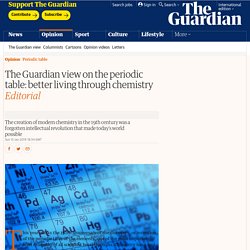
Chemistry has a bad reputation among non-chemists, perhaps because it is the first place in science where a schoolchild comes up against the stubborn complexity of nature. The organising principles of physics appear simple; evolution makes biology appear a well-ordered process, at least until it’s examined in detail. But chemistry is awkward and lumpy. There are endless facts to memorise, and there are few obvious and intuitively pleasing answers to questions such as why the periodic table has eight columns and not seven or nine.
There is not even a hero figure like Darwin, Newton or Einstein whose story can dramatise our understanding of the subject. This was not a complete theoretical understanding, but it exposed the phenomena which a theory must explain. ChemSpider Reviews. Ionic and Molecular Compounds. News - Chemistry Now. Beautiful Chemistry. FREE Chemistry Resources for Middle and High School - Ben and Me. November 8 - On This Day in Chemistry. He produced the first X-ray images picturing the bones in his wife’s hand.

Infotopia: Chemistry. Four Essential Ingredients of the Human Body. September 20 - On This Day in Chemistry. His work blurred the line between chemistry and physics.
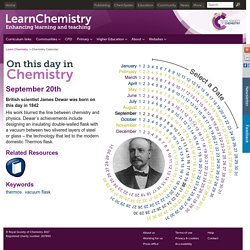
Dewar’s achievements include designing an insulating double-walled flask with a vacuum between two silvered layers of steel or glass – the technology that led to the modern domestic Thermos flask. Related Resources. Interactive Periodic Table of the Elements, in Pictures and Words. The Map of Chemistry: New Animation Summarizes the Entire Field of Chemistry in 12 Minutes. Philosophers, technologists, and futurists spend a good deal of time obsessing about the nature of reality.

Recently, no small number of such people have come together to endorse the so-called “simulation argument,” the mind-boggling, sci-fi idea that everything we experience exists as a virtual performance inside a computer system more sophisticated than we could ever imagine. It’s a scenario right out of Philip K. Dick, and one Dick believed possible. It’s also, perhaps, terminally theoretical and impossible to verify. So... where might the perplexed turn should they want to understand the world around them? Walliman’s ingenious teaching tools excel in conveying a tremendous amount of complex information in a comprehensive and intelligible way. Energy Foundations for High School Chemistry.
What's an Ion? Lewis Dot Structures, Formula Units & Ionic Formulas - CLEAR & SIMPLE. How to Write Chemical Formulas from Compound Names. Oxidation reduction. Molecular Polarity. Polarity - Dipole: Polarity results from the uneven partial charge distribution between various atoms in a compound.
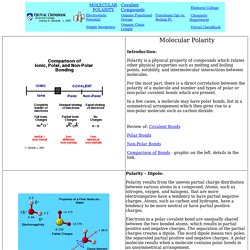
Atoms, such as nitrogen, oxygen, and halogens, that are more electronegative have a tendency to have partial negative charges. Atoms, such as carbon and hydrogen, have a tendency to be more neutral or have partial positive charges. Electrons in a polar covalent bond are unequally shared between the two bonded atoms, which results in partial positive and negative charges. The separation of the partial charges creates a dipole. Nonpolar molecules are of two types. Construct a Lewis Structure. Redox Rules. Click to download REDOX RULES posters for VCE Chemistry What’s redox?
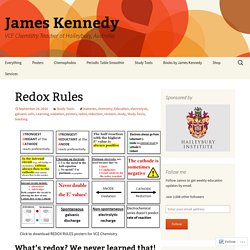
We never learned that! Yes, you did. I use the term “redox” to refer to all of the following chapters in Heinemann Chemistry 2, which you will have learned at the end of Term 3 (September). Chapter 26: Redox (revision of Year 11)Chapter 27: Galvanic CellsChapter 28: Electrolytic Cells Don’t underestimate redox The VCAA has consistently used redox to discriminate which schools and students have the self-discipline required to keep studying at the end of the year. Here are some popular redox lies (misconceptions) LIE #1: The polarities switch during rechargeNope. LIE #2: Hydrogen fuel cells don’t emit any greenhouse gasesWrong.
LIE #3: Each mole of electrons forms 1 mol Ag, 2 mol Cu or 3 mol Al in a cellWrong again. LIE #4: Temperature increases the rate of reaction in electroplating Wrong! LIE #5: Electrons always leave the anode and go towards the cathodeWrong again. Teach "naming compounds" with a decision tree - Jen Siler's Classroom. Naming compounds was a frustrating topic This is a topic that my Chemistry students always struggled with.
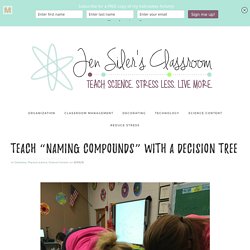
There are just so many rules! They were becoming frustrated and giving up. So I did what I always do when my kids are having trouble. I reflected on the lesson and thought of ways to make it more accessible. 50 Awesome Chemistry Videos For The Busy Science Teacher. Though we don’t often recognize it, chemistry defines nearly every element of our everyday lives.

From the reactions that fuel the sun to the biology of our bodies to the technology in our gadgets, chemistry is at the heart of everything we do and is the central science that unites biology, physics, geology, astronomy, medicine, and countless other fields. Yet chemistry doesn’t always get the credit and recognition it deserves for playing such an awesome role in, well, everything. If you’ve been slighting chemistry, there’s no better time to give the field the credit it deserves than National Chemistry Week. Founded in 1987, the week-long event has helped bring awareness to the role chemistry plays both in our lives today and in our future.
Chemicals in the Home : Basic Chemistry. This page is intended to help students of basic (school-level) chemistry with questions such as: The following table of the chemical names and molecular formulae of common chemicals is arranged in alphabetical order of the common (often "household" or "domestic") name of the chemical.
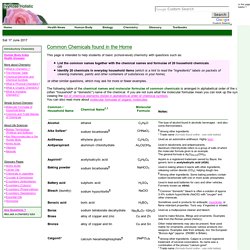
Chemistry, Organic Chemistry and Periodic Table. Chemistry Techniques – Titration. Click to enlarge Anyone who’s studied chemistry will be overly familiar with titrations. It’s an analytical technique that can be used to find the concentration of a solution (the amount of a solute dissolved in it). I put this graphic together primarily to remind my A level students of some of the key aspects of titrations, but as well as being a handy guide for them, it’s a useful introduction to the technique for non-chemists too! Students are usually introduced to titrations in the context of reactions between acids and alkalis. As many of you might well recall, this is known as a neutralisation reaction. Find chemistry lesson plans, labs, demos, activities and more for high, middle, and elementary school. Naming Compounds Containing Polyatomic Ions. Chemical Formulas. Chemical Science Resources.
ChemGameTutor. The Particle Adventure. Chemistry — Cooler Than Absolute Zero! Here’s a look at the remarkable properties of ten of the periodic table’s elements. The first on our list was hailed as the philosophers’ stone when it was discovered. 1. Phosphorus Phosphorus was the first element ever isolated scientifically. In 1669 Hennig Brand evaporated water from urine, then allowed the residue to fester for a few months. Compound Interest. ChemGameTutor. Chemistry Guide - Chemistry Search Engine. Chemistry help, high school chemistry, college chemistry, chemistry tutorial, chemistry. Rader's CHEM4KIDS.COM - Chemistry basics for everyone! Education. Download Free Science Activities, Access Chemistry Multimedia, Find Information on Workshops.
Welcome to the Chemical Education Digital Library. ChemCollective. Chemistry resources for Teachers and Students. Home. Common Compound Library A searchable database of over 800 common compound names, formulas, structures, and properties. Companion Notes Hyperlinked notes and guides for first semester general chemistry. Construction Kits Flash-based kits for building chemical formulas, names, equations, and problem solutions. Articles Featured articles, books, and tutorials. Toolbox Interactive graphing, popup tables, and calculators.
Virtual Labs. The Virtual Lab is an online simulation of a chemistry lab. It is designed to help students link chemical computations with authentic laboratory chemistry. The lab allows students to select from hundreds of standard reagents (aqueous) and manipulate them in a manner resembling a real lab. More information and offline downloads. Please scroll below to find our collection of pre-written problems, they have been organized by concept and ranked by difficulty. Stoichiometry The Mole, Molarity, and Density Glucose Dilution Problem In this activity, students use the virtual lab to create a 0.025M glucose solution from a standard 1M glucose solution. Science for Kids. Water is an amazing substance! It can form into a beautiful snowflake in its solid state or evaporate into the air as a gas.
Experiment with solids, liquids and gases to learn more about these states of matter. How do objects move? How far can a rubber band stretch? How does energy affect what we can see, hear or feel? Virtual Chemistry Experiments. Dynamic Periodic Table. 50 Awesome Chemistry Videos For The Busy Science Teacher. Though we don’t often recognize it, chemistry defines nearly every element of our everyday lives. The ABC's of gas: Avogadro, Boyle, Charles - Brian Bennett. Materialchange.swf (application/x-shockwave-flash Object) Primary School Chemistry.
Elements. Introduction to DNA.